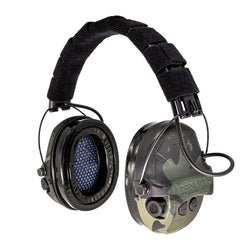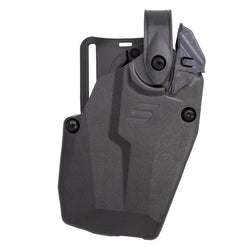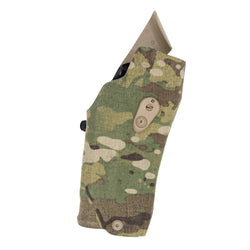When I say “police revolver,” I bet you picture a Smith and Wesson K-Frame with a four-inch barrel. You might not even know it, but it’s likely a S&W M&P or some variation of that gun.
The S&W M&P has many names, but this medium-frame revolver in .38 Special is the quintessential cop revolver. It started as the Smith & Wesson .38 Hand Ejector Model of 1899, then developed into the S&W M&P, then the Victory Model, and finally it settled on the Model 10.

This gun has various names because Smith and Wesson changed their naming conventions several times. This wasn’t something they did over a short period. The gun has just remained in production that long. The S&W M&P in .38 Special armed police officers across the country from 1920 up into the 1980s.

Bill Rogers, the man who created the first Kydex holster, created it for a variant of this revolver known as the Model 10. It’s just been around forever, and for good reason. My specific model is an S&W M&P model dating back to the 1940s. Today, we are going to dissect all of these various models, trace the numerous variants of these guns, and discuss what made them so popular.
The S&W M&P Through The Years
The first variant of this Smith and Wesson revolver went by a mighty long name. It was the Smith & Wesson .38 Hand Ejector Model of 1899. S&W did not believe in brevity, and SEO hadn’t been created, so they went wild. This first gun didn’t chamber the legendary.38 Special. Instead, it chambered the .38 Long Colt.
The US Army and Navy ordered several thousand revolvers for the .38 Long Colt, the era’s sidearm caliber. After placing the order, S&W adopted the Military and Police (M&P) moniker for the gun. The .38 Long Colt proved to be highly ineffective in combat. In response, S&W developed the .38 S&W Special by amping up the bullet weight and grains of gunpowder.

Over the years, several gun variants were released along with several different barrel lengths. In 1915, S&W released the .38 S&W Military & Police Model of 1905 4th Change. This particular model was used extensively during World War 1 with Allied Forces. They remained popular into World War 2.
Variants produced from 1942 to 1944 had a V prefix. These became known as the S&W Victory Model. American soldiers and numerous Allied Forces carried the revolver in a variety of calibers. They were used by Aircrews and non-frontline positions, including military police and stateside guards. These Victory models often had a parkerized finish, a lanyard loop, and smooth walnut grips.

After World War 2, production of the standard M&P resumed. S&W decided to standardize their naming conventions and, in the late 1950s, went with model numbers. The S&W M&P became the S&W Model 10.
The S&W M&P: Inside and Out
Semi-automatic pistols slowly became the standard during the early 1900s. America adopted the M1911 prior to World War 1 and used revolvers as supplementary weapons. Police forces were much slower to adapt for varied reasons. It’s easy to use budgetary reasons, but there was more to it than that.
We now live in the golden era of semi-auto handguns. They’ve never been more reliable. However, this wasn’t always the case. Back in the day, the issue wasn’t just the guns themselves — ammo wasn’t as reliable, consistent, or secure as it is now. In that era, revolvers truly were more reliable. Police were much more likely to employ a handgun than soldiers, so reliability was a top concern.

The S&W M&P provided a modern, reliable revolver with a controllable cartridge. S&W also constantly evolved the M&P series. They implemented improvements for safety, reliability, and ease of production. Collectors aim to purchase models known as five or four-screw models that signify different eras of production.
The base model S&W M&P are six shot .38 Special revolvers. They are considered medium-frame guns. They have produced both square and round butt models, and you’ll find various hammer and safety designs. The same goes for sights. Most used a standard fixed front sight and rear trench sight. Target models were also popular for nonduty roles.

The guns feature a hand ejector, which means it has a rod that presses cases out of the cylinder. The S&W M&P’s overall design didn’t change much. Every change was small, and the guns have always been double-action revolvers with swing-out cylinders and hand ejectors. In many ways, they were the Glock 19 of their day.
Shooting the S&W M&P
Revolvers haven’t changed drastically since the M&P. If you enjoy revolvers, the standard M&P with a four-inch barrel and fixed sights won’t feel out of pocket. The gun feels hefty. It’s big but comfy.
The recoil is fairly light and minimal. Standard .38 Special loads handle nicely in the big gun. I’ve grown accustomed to lightweight .38s, but this old, heavy K-frame eats recoil like a monster.
My model lacks the stock grips. Somewhere in its lifespan, someone installed a big Pachmayr grip. I’d prefer the classic wood, but what’s a guy to do? The big grips admittedly help with control and do provide more grip for my big hands. (I’m still going to swap them for standard wood stocks.)

For me, the bane of revolver shooting comes down to the sights. I suck with a rear trench and fixed front sight. I really need a rear sight. That’s true with all revolvers, including this old M&P. I can put .38 Special-sized holes into a target’s chest at 25 yards all day, but the group looks more like a pattern. I guess it’s good enough, but I’m spoiled by red dots and rear sights, which help me make tighter groups.
The old S&W triggers roll oh-so perfectly. The trigger is very smooth and quite nice. It’s a very manly fidget toy, as far as I’m concerned. It’s easy to understand why the S&W M&P revolvers were so popular for so long. They give us reliability, low recoil, and great triggers, and for shooters better than me, they are plenty accurate.

A Legend
The S&W M&P is up there with the Glock, the M1911, and the Colt Single Action Army in the sidearm hall of fame. It’s a fantastic firearm, everything a revolver should be. It’s such a legend that S&W still uses the M&P title to advertise their striker-fired, polymer-frame pistols. The Model is still being produced, but it is a stainless gun known as the Model 64.
While cops might have swapped to automatics, the M&P served its country and community well.









